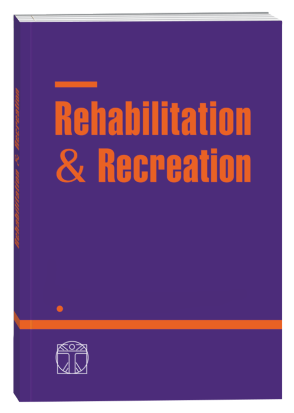HEALTH CARE TECHNOLOGIES IN CREATING OPTIMAL WORKING CONDITIONS IN HIGHER EDUCATION INSTITUTIONS
DOI:
https://doi.org/10.32782/2522-1795.2023.15.1Słowa kluczowe:
neck-shoulder syndrome, osteochondrosis, degenerative-destructive disorders.Abstrakt
Neck-shoulder syndrome is a real problem in general clinical practice, manifested by pain, reflex myotonic symptoms in the cervical spine and upper limbs. The goal of our research was a comprehensive study of the clinical and instrumental aspects of the neck-shoulder syndrome for the development of a preventive program and rehabilitation tactics. Materials and methods. We examined 103 people aged 18 to 50 years with clinical manifestations of reflex syndromes of cervical osteochondrosis in the form of cervicocranial pains, who underwent outpatient examination on the basis of National University «Yuri Kondratyuk Poltava Polytechnic» and the Skalyansky Clinic. Among them, 84 (78.64%) patients were women, 22 (21.36%) were men. The duration of having the neck-shoulder syndrome was from 1 to 10 years. The analysis of the obtained data revealed a mixed (musculovascular) mechanism of cervicocranial pain, which is a clinical manifestation of reflex syndromes of cervical osteochondrosis in young people. In this regard, it is advisable to include anti-inflammatory drugs (xefokam, denebol, olfen, nimesil, sigan, etc.), muscle relaxants (midokalm, sirdalud), vascular and venotonics (L-lysine escinat, troxevasin, actovegin) in the complex treatment of this category of patients , nicotinic acid preparations, etc.), vegetotropic drugs, as well as drugs that reduce irritative-paroxysmal phenomena and affect the pain syndrome (gabantine, lamotrine), antidepressants (amitriptyline, fluoxetine, etc.), physiotherapeutic methods and physical therapy. Conclusions. Modern diagnostics and a rational approach to treatment will further lead to early rehabilitation of patients and increase the working capacity of young patients with cervicocranial pain on the background of osteochondrosis of the cervical spine.
Bibliografia
Ahmed, S., Mishra, A., Akter, R., Shah, M. H., & Sadia, A. A. (2022). Smartphone addiction and its impact on musculoskeletal pain in neck, shoulder, elbow, and hand among college going students: a cross-sectional study. Bulletin of Faculty of Physical Therapy, 27(1), 5.
Attia, A. M. M., Aboelnour, N. H., Sherif, R. A., & Saafaan, K. I. (2022). The effect of Manual Pressure Release and Scapular Stabilization Exercises on Myofascial Pain Syndrome Following Neck Dissection Surgery. The Egyptian Journal of Hospital Medicine, 89(1), 4668-4675.
Cao, Q. W., Peng, B. G., Wang, L., Huang, Y. Q., Jia, D. L., Jiang, H., ... & Huang, D. (2021). Expert consensus on the diagnosis and treatment of myofascial pain syndrome. World journal of clinical cases, 9(9), 2077.
Chiu, Y. C., Manousakas, I., Kuo, S. M., Shiao, J. W., & Chen, C. L. (2020). Influence of quantified dry cupping on soft tissue compliance in athletes with myofascial pain syndrome. PLoS One, 15(11), e0242371.
Duarte, F. C., West, D. W., Linde, L. D., Hassan, S., & Kumbhare, D. A. (2021). Re-examining myofascial pain syndrome: toward biomarker development and mechanismbased diagnostic criteria. Current Rheumatology Reports, 23, 1-10.
Fernández-de-Las-Peñas, C., & Nijs, J. (2019). Trigger point dry needling for the treatment of myofascial pain syndrome: current perspectives within a pain neuroscience paradigm. Journal of pain research, 1899-1911.
Galasso, A., Urits, I., An, D., Nguyen, D., Borchart, M., Yazdi, C., ... & Viswanath, O. (2020). A comprehensive review of the treatment and management of myofascial pain syndrome. Current pain and headache reports, 24, 1-11.
Horoshko, V. І. (2022). Myofascial neck pain syndrome in wrestling athletes: prevention and recovery. Clinical and preventive medicine, 3(21), 42-47.
Imran, K., Khan, M. I., Zaib, H. M. J., Nazir, F., Khan, N. A., & Khalid, A. (2023). Risk Factors of Computer Vision Syndrome and its Prevention. Pakistan Journal of Medical & Health Sciences, 17(01), 475-475.
Ojala, T., Arokoski, J. P., & Partanen, J. (2006). The effect of small doses of botulinum toxin a on neck-shoulder myofascial pain syndrome: a double-blind, randomized, and controlled crossover trial. The Clinical journal of pain, 22(1), 90-96.
Pobrania
Opublikowane
Jak cytować
Numer
Dział
Licencja

Utwór dostępny jest na licencji Creative Commons Uznanie autorstwa – Użycie niekomercyjne – Bez utworów zależnych 4.0 Międzynarodowe.











